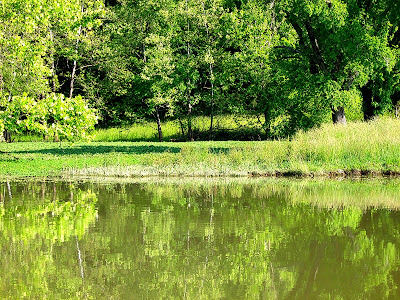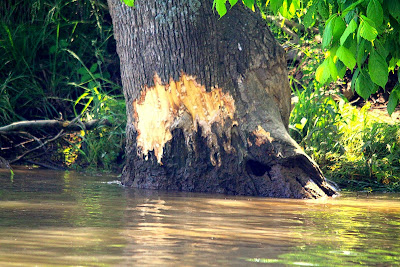That little black pointer on the wide blue line is me travelling down the shoreline of the Holston River today. That GPS is really great!
I know today is a holiday and I have it off, but I elected to follow my schedule and get on the Holston River. Why not? That's where I would have gone in my personal boat if I took the day off. Told-ja - I love my job!
This blog entry may seem a little different. Actually, it is a little different. I'm going to try to explain what I see, how I look at and extrapolate a camera image from a panoramic scene when I'm out here. I was thinking last night about how I project the image of heaven when I talk about this river. It might not be someone elses dream water just because it's mine. It's all how a body looks at things. I certainly wouldn't want folks flocking here to Beech Creek to pan the gold dust from the water because of something I said about it. I got to thinking that I probably don't view the scenery and images the same way as others do. I learned a long time ago to not only look but to also see. In order to see, one has to find first, the look part - then one must really see what one is looking at, and that is key to finding not only critters but unique content in the details of the view. These details are what the camera lens should be pointed at. The details of the "big" scenic picture are the river, grass alongside the river, beds of cattails, mountains in the background and a deep blue sky.
I certainly am not an expert photographer. Most of what I know is self taught with the help of the internet, but I do know how to look, see and find. I learned a long time ago in the Army not to get all wrapped up in the big picture. The major view before one should be split into four quadrants each of which can now be looked at in order to see and find some unique subject to photograph. The bald eagle sitting in a tree and almost hidden behind dense foliage would go overlooked if one dwells on how beautiful the panoramic view before them is. The panoramic view is the result of combined quadrants. The sum of the quadrants equals the whole. Getting heavy here!
When travelling down the edge of the river I look at how beautiful and full the leaves are on the trees and the combination of all the foliage along the water creates a gorgeous panoramic scene. If I select one tree and really look at it I can "see" the unique qualities about it. For instance - the otter's lair exists under that tree.
If I study the tree from the top down I can discover many things like a song sparrow singing his heart out. He appears insistent that he be heard and will not take no for an answer. "Here I am. Look at me."
Nothing can quiet him - except for an itch that demands scratching.
A particularly pretty tree with vibrant foliage came into view and it was healthy and gorgeous. I split the tree into four sections and investigated, looked, at one section, quadrant, at a time until I either discovered something of interest or not.
After "looking" I could "see" that one of the quadrants contained a speck of blue.
See how it works? So, when I explain how beautiful this river is I'm talking about the small picture as well as the big, panoramic picture.
Even a bird can be broken down into quadrants. Head, upper body, mid body, legs and feet. Note the orange on the beak of the double crested cormorant. That is one unique feature of the bird, but the real point of interest is how the cormorant wraps his "webbed" feet around the limb. Webbed feet are not designed to perch on limbs, but the feet of these birds have claws that act as anchors on the edges of the wood. I made sure the feet were in the shot.
Look at those feet! Cormorants are very common in the waters of East Tennessee, but they are unique unto themselves.
We'll do one more.
Look how saturated the greens are on the above shoreline shot. The sun drives through the green foliage and seems to enrich the already vibrant greens to brilliant green. Over beside that tree and slightly behind is a place where floating wood has piled up. The trees shade that wood pile. I noticed it when I took the photo above. Now, I cropped the shot so the wood pile is not in the shot now. I angled the boat toward the shore so that I could view the woodpile at the water line through the binoculars. I am desperate to find an otter. One otter! There was no otter but there was a scamp squirrel. The wood pile and squirrel would be in the second quadrant of the photo had I not cropped the shot.
He suddenly jumped straight up to the next level of wood. He moved so quick I almost missed the shot. Guess I missed half the shot anyway. There's an interesting thing happens when animals move quickly. I can have the camera lens right on the animal, finger on the shutter, camera steady and ready, and when the animal makes his move - it's so fast that I am startled for one heart beat and push the shutter button late. That's that happened in the shot below. It happens when birds launch into flight from a limb.
See what I mean?
I think you see what I'm trying to explain with all this. We'll do one more and I'll stop this babble.
A line of cattails bordered the water at the edge of the river's edge. The big picture was gorgeous.
Careful investigation of the scene showed two black specs within the cattail section of the image. As the boat floated past and closer it was plain they were red winged black birds, another very, very common bird along the river and considered a pest by farmers. They are, however, a very pretty bird.
How about a king bird.
King birds have that distinct black cap on their head that extends down to just below their eyes. It is most difficult to see a king bird's eyes because of that cap or hood.
The worn path through the reeds above was made by a beaver while on his daily journey to and from his lodge which is hidden far back in the greenery away from the river.
Their constant honking can be heard coming closer and closer. I really like wild geese, especially when the burst upon the scene in the formation they are famous for.
They are chasing the wind.
Looks like a near collision in the lower shot, bottom right corner.
I put the binoculars on the tiny plot of land that I call Goose Island and saw a rather heart warming vision.
The mother goose sat on her eggs here on this spot for many days and nights until her babies emerged. And, she sat with them for many more days and nights acting as a protective structure for her tiny newborns. I have driven past her day after day just waiting for a glimpse of her chicks. I never saw them. She hid them well from the view of all. That was three weeks ago. She had built a soft nest of grass and lined it with plumage that she plucked from her body. After all the time that had passed from then until now - there still remains one tiny piece of evidence that new life existed here.
But, where are the otters?
The trapper has done a good job. Damn him! At least he didn't get all the beavers. Their pelts don't bring as much blood money as the otter pelts do.
Time was flying and I was nearing Beech Creek and the truck. This river is truly beautiful. It belongs to the artists and real photographers of the world. They are the only one's who can accurately record its natural beauty.
And, a tiny living entity clings to existence at the end of a ridiculously fragile umbilical cord.
Now, this is a river!
This blog is a visual record of my outings into the streams, lakes and forests of Tennessee and North Carolina by canoe, motor boat and motorcycle. I love photography and use that venue to record wildlife and wilderness scenes for my personal enjoyment. I enjoy writing short stories also and do so while out in the forests or on the lakes. I also am addicted to dogs as will be apparent as you read my blog. But, the canoe is my favorite means of escape and wilderness camping is a joy.




















































Sweet Gary what a beautiful day. Wish I had something like this haven to enjoy. Thank you for sharing.
ReplyDeleteAnne
Very thoughtful and informative and a lot of great pics. A very enjoyable entry.
ReplyDelete